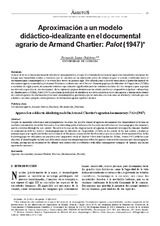Mostrar el registro sencillo del ítem
Aproximación a un modelo didáctico-idealizante en el documental agrario de Armand Chartier: Palot (1947)
| dc.contributor.author | Luque Gutiérrez, Fernando | |
| dc.date.accessioned | 2023-03-20T12:19:43Z | |
| dc.date.available | 2023-03-20T12:19:43Z | |
| dc.date.issued | 2022 | |
| dc.identifier.issn | 1575-2100 | |
| dc.identifier.issn | 2386-4494 | |
| dc.identifier.uri | http://hdl.handle.net/10396/25014 | |
| dc.description.abstract | A pesar de su vocación eminentemente educativa y propagandística, el específico formato de documental agrario ha demostrado con el paso del tiempo una versatilidad estética y narrativa que lo convierte en un interesante punto de referencia para el estudio y reflexión sobre el documentalismo cinematográfico, y su evolución a través del pasado siglo. Este artículo pone el foco de atención en el particular modelo de documental agrario desarrollado por Armand Chartier en colaboración con el Service Cinématographique du Ministère de l’Agriculture (SCMA) a mediados del siglo pasado, un momento histórico especialmente significativo para las corrientes realistas del cine europeo y para la propia noción teórico-práctica de cine documental. En las siguientes páginas abordaremos un estudio analítico y comparativo del primer cortometraje de Chartier para el SCMA, Palot (1947), con el principal objetivo de identificar las claves estilísticas de su cine agrario, e interpretarlas dentro del contexto general del documental y realismo cinematográfico, prestando especial atención a las relaciones de afinidad y contraste que este establece con otros ejemplos contemporáneos de documental agrario español e italiano. | es_ES |
| dc.description.abstract | Despite its eminently educational and propagandistic vocation, the specific format of agrarian documentary has demonstrated over time an aesthetic and narrative versatility that makes it an interesting point of reference for the study and reflection on cinematographic documentary, and its evolution through the last century. This article focuses on the singular model of agrarian documentary developed by Armand Chartier in collaboration with the Service Cinématographique du Ministère de l’Agriculture (SCMA) in the middle of the last century, a historical moment especially significant for the realist currents of European cinema and for the theoretical-practical notion of documentary film. In the following pages we will address an analytical and comparative study of Chartier’s first short film for the SCMA, Palot (1947), with the main objective of identifying the stylistic keys of his rural cinema and interpreting them within the general context of documentary and cinematographic realism, paying special attention to the affinity and contrast that it establishes with other contemporary examples of Spanish and Italian agrarian documentary. | es_ES |
| dc.format.mimetype | application/pdf | es_ES |
| dc.language.iso | spa | es_ES |
| dc.publisher | Asociación de Estudios de Ciencias Sociales y Humanidades | es_ES |
| dc.rights | https://creativecommons.org/licenses/by-nc-nd/4.0/ | es_ES |
| dc.source | Ámbitos 48, 25-38 (2022) | es_ES |
| dc.subject | Documental agrario | es_ES |
| dc.subject | Chartier, Armand, 1914-2002 | es_ES |
| dc.subject | Realismo | es_ES |
| dc.subject | Mecanización | es_ES |
| dc.subject | Ruralidad | es_ES |
| dc.subject | Agrarian documentary | es_ES |
| dc.subject | Realism | es_ES |
| dc.subject | Mechanization | es_ES |
| dc.subject | Rurality | es_ES |
| dc.title | Aproximación a un modelo didáctico-idealizante en el documental agrario de Armand Chartier: Palot (1947) | es_ES |
| dc.title.alternative | Approach to a didactic-idealizing model in Armand Chartier’s agrarian documentary: Palot (1947) | es_ES |
| dc.type | info:eu-repo/semantics/article | es_ES |
| dc.relation.projectID | Gobierno de España. PID2019-105462GB-I00 | es_ES |
| dc.rights.accessRights | info:eu-repo/semantics/openAccess | es_ES |

